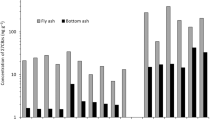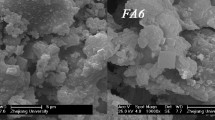Abstract
Chlorinated benzenes (CBzs) are a group of organic pollutants, which have been industrially or unintentionally produced through various chemical and thermal processes. Studies on full congener profiles of CBzs in waste and environmental samples are relatively limited and not updated. In the present study, concentrations of 12 CBzs were determined in fly ash (FA) and bottom ash (BA) samples collected from one municipal waste incinerator (MWI) and one industrial waste incinerator (IWI) in northern Vietnam. Levels of Σ12CBzs were higher in bottom ash (median 25.3; range 1.59–45.7 ng/g) than in fly ash (median 7.30; range 1.04–30.0 ng/g). The CBz profiles were dominated by di- and tri-chlorinated congeners with the major congeners as 1,2,4-TCB, 1,2,3-TCB, 1,2-DCB, and 1,3-DCB. However, CBz profiles varied greatly between sample types and incinerators, implying differences in input materials, formation pathways, and pollutant behaviors. Incomplete combustion is possibly responsible for high levels of CBzs in industrial bottom ash. The emission factors of Σ12CBzs ranged from 21 to 600 µg/ton for fly ash and from 190 to 4570 µg/ton for bottom ash, resulting in annual emissions of about 6 and 3 g/year for the IWI and MWI, respectively. Our results suggest additional investigations on industrial emission and environmental occurrence of all 12 CBzs rather than solely focusing on regulated congeners like hexachlorobenzene and pentachlorobenzene.



Similar content being viewed by others
Data Availability
All data generated or analyzed during this study are included in this published article and its supplementary information files.
References
Adrian L, Görisch H (2002) Microbial transformation of chlorinated benzenes under anaerobic conditions. Res Microbiol 153:131–137
ATSDR (US Agency for Toxic Substances and Disease Registry) (2006) Toxicological Profile for Dichlorobenzenes. https://www.atsdr.cdc.gov/toxprofiles/tp10-p.pdf (accessed 10 May 2023)
ATSDR (2020) Toxicological Profile for Monochlorobenzene. https://www.atsdr.cdc.gov/toxprofiles/tp131-p.pdf (accessed 10 May 2023)
ATSDR (2015) Toxicological Profile for Hexachlorobenzene. https://www.atsdr.cdc.gov/toxprofiles/tp90.pdf (accessed 10 May 2023)
ATSDR (2014) Toxicological Profile for Trichlorobenzenes. https://www.atsdr.cdc.gov/ToxProfiles/tp199.pdf (accessed 10 May 2023)
Babich H, Borenfreund E (1988) Structure-activity relationships for diorganotins, chlorinated benzenes, and chlorinated anilines established with bluegill sunfish BF-2 cells. Fundam Appl Toxicol 10:295–301
Bailey RE (2001) Global hexachlorobenzene emissions. Chemosphere 43:167–182
Bailey RE, van Wijk D, Thomas PC (2009) Sources and prevalence of pentachlorobenzene in the environment. Chemosphere 75:555–564
Banaee J, Larson RA (1995) Co-combustion of a chlorinated polymer with high-sulfur coals and other polymeric materials: inhibition of the formation of chlorinated benzenes. Waste Manag 15:609–614
Beck U, Löser E (2012) Chlorinated benzenes and other Nucleus-Chlorinated Aromatic hydrocarbons. Ullmann’s encyclopedia of Industrial Chemistry volume 8. Wiley-VCH, Weinheim, pp 483–519
Brahushi F, Kengara FO, Song Y, Jiang X, Munch JC, Wang F (2017) Fate processes of chlorobenzenes in soil and potential remediation strategies: a review. Pedosphere 27:407–420
Calamari D, Galassi S, Setti F, Vighi M (1983) Toxicity of selected chlorobenzenes to aquatic organisms. Chemosphere 12:253–262
Chen B, Perumal P, Illikainen M, Ye G (2023) A review on the utilization of municipal solid waste incineration (MSWI) bottom ash as a mineral resource for construction materials. J Build Eng 71:106386
den Besten C, Vet JJRM, Besselink HT, Kiel GS, van Berket BJM, Beems R, van Bladeren PJ (1991) The liver, kidney, and thyroid toxicity of chlorinated benzenes. Toxicol Appl Pharmacol 111:69–81
Froese KL, Hutzinger O (1994) The formation of chlorinated benzenes and phenols in flyash catalysed reactions of trichloroethylene. Chemosphere 28:1977–1987
Huang Y, Takaoka M, Takeda N (2003) Chlorobenzenes removal from municipal solid waste incineration fly ash by surfactant-assisted column flotation. Chemosphere 52:735–743
Hue NT, Nguyen TPM (2021) Emission characterization of PeCB, HCB and their correlation in fly and bottom ashes from various thermal industrial processes in Northern Vietnam. Hum Ecol Risk Assess 27:378–391
Hue NT, Thuy NTT, Tung NH (2016) Polychlorobenzenes and polychlorinated biphenyls in ash and soil from several industrial areas in North Vietnam: residue concentrations, profiles and risk assessment. Environ Geochem Health 38:399–411
IARC (2001) IARC Monographs on the Evaluation of Carcinogenic Risks to Humans Volume 79 Some Thyrotrophic Agents. https://monographs.iarc.who.int/wp-content/uploads/2018/06/mono79.pdf (accessed 1 June 2023)
IARC (International Agency for Research on Cancer) (1999) IARC Monographs on the Evaluation of Carcinogenic Risks to Humans Volume 73 Some Chemicals that Cause Tumours of the Kidney or Urinary Bladder in Rodents and Some Other Substances. https://publications.iarc.fr/_publications/media/download/2435/eabe702c13ae4828853cb8fdb7fa65 2ae1d3b627.pdf (accessed 1 June 2023)
Imagawa T, Takeuchi M, Miyazaki A, Tanaka T (1989) Formation of chlorinated benzenes, naphthalenes and dibenzofurans in the pyrolysis of Chlordane. Chemosphere 19:717–720
Khumsaeng T, Oanh NTK, Kare KH, Polprasert C (2013) Emission of dioxins/furans and other U-POPs from test burns of non-POP pesticides in a hazardous waste incinerator. Waste Manag 33:833–841
Lee CL, Song HJ, Fang MD (2000) Concentrations of chlorobenzenes, hexachlorobutadiene and heavy metals in surficial sediments of Kaohsiung coast, Taiwan. Chemosphere 41:889–899
Li X, Ren Y, Ji S, Hou X, Chen T, Lu S, Yan J (2015) Emission characteristics of hazardous components in municipal solid waste incinerator residual ash. J Zhejiang Univ Sci A 16:316–325
Lin Y, Zhou S, Lee WJ, Wang LC, Chien GPC, Lin WC (2014) Size distribution and leaching characteristics of poly brominated diphenyl ethers (PBDEs) in the bottom ashes of municipal solid waste incinerators. Environ Sci Pollut Res 21:4614–4623
Linko P, Yeowell HN, Gasiewicz TA, Goldstein JA (1986) Induction of cytochrome P-450 isozymes by hexachlorobenzene in rats and aromatic hydrocarbon (Ah)—responsive mice. J Biochem Toxicol 1:95–107
Meharg AA, Wright J, Osborn D (2000) Chlorobenzenes in rivers draining industrial catchments. Sci Total Environ 251–252:243–253
Morita M (1977) Chlorinated benzenes in the environment. Ecotoxicol Environ Safe 1:1–6
Nguyen TH, Nguyen TTT, Tung NH, Hoang AQ, Pham LH, Minh TB (2019) Levels, profiles, and emission characteristics of chlorobenzenes in ash samples from some industrial thermal facilities in northern Vietnam. Environ Sci Pollut Res 26:188–198
Nguyen TTT, Hoang AQ, Nguyen VD, Nguyen HT, Vu TV, Vuong XT, Tu MB (2021) Concentrations, profiles, emission inventory, and risk assessment of chlorinated benzenes in bottom ash and fly ash of municipal and medical waste incinerators in northern Vietnam. Environ Sci Pollut Res 28:13340–13351
Nishimura C, Suzuki G, Matsukami H, Agusa T, Takaoka M, Takahashi S, Tue NM, Viet PH, Tanabe S, Takigami H, Fujimori T (2018) Soil pollution by chlorobenzenes and polychlorinated biphenyls from an electronic waste recycling area in Northern Vietnam. Int J Environ Pollut 63:283–297
Nowakowska M, Szczubiałka K (1999) Photosensitized dechlorination of polychlorinated benzenes. 1. Carbazole-photosensitized dechlorination of hexachlorobenzene. Chemosphere 39:71–80
Öberg T, Öhrström T, Bergström J (2007) Metal catalyzed formation of chlorinated aromatic compounds: a study of the correlation pattern in incinerator fly ash. Chemosphere 67:S185–S190
Öberg T, Bergbäck B, Filipsson M (2008) Catalytic effects by metal oxides on the formation and degradation of chlorinated aromatic compounds in fly ash. Chemosphere 71:1135–1143
Pekárek V, Weber R, Grabic R, Šolcová O, Fišerová E, Šyc M, Karban J (2007) Matrix effects on the de novo synthesis of polychlorinated dibenzo-p-dioxins, dibenzofurans, biphenyls and benzenes. Chemosphere 68:51–61
Procaccini C, Bozzelli JW, Longwell JP, Sarofim AF, Smith KA (2003) Formation of chlorinated aromatics by reactions of Cl•, Cl2, and HCl with benzene in the cool-down zone of a combustor. Environ Sci Technol 37:1684–1689
Ryu JY (2008) Formation of chlorinated phenols, dibenzo-p-dioxins, dibenzofurans, benzenes, benzoquinnones and perchloroethylenes from phenols in oxidative and copper (II) chloride-catalyzed thermal process. Chemosphere 71:1100–1109
Shane BS, Henry CB, Hotchkiss JH, Klausner KA, Gutenmann WH, Lisk DJ (1990) Organic toxicants and mutagens in ashes from eighteen municipal refuse incinerators. Arch Environ Contam Toxicol 19:665–673
Shen C, Tang X, Yao J, Shi D, Fang J, Khan MI, Cheema SA, Chen Y (2010) Levels and patterns of polycyclic aromatic hydrocarbons and polychlorinated biphenyls in municipal waste incinerator bottom ash in Zhejiang Province, China. J Hazard Mater 179:197–202
Stach J, Pekáarek V, Endršt R, Hetflejš J (1999) Dechlorination of hexachlorobenzene on MWI fly ash. Chemosphere 39:2391–2399
Stockholm C (2020) Stockholm Convention on Persistent Organic Pollutants (POPs) Text and Annexes Revised in 2019. https://chm.pops.int/theconvention/overview/textoftheconvention/tabid/2232/default.aspx (accessed 1 June 2023)
Takaoka M, Liao P, Takeda N, Fujiwara T, Oshita K (2003) The behavior of PCDD/Fs, PCBs, chlorobenzenes and chlorophenols in wet scrubbing system of municipal solid waste incinerator. Chemosphere 53:153–161
Taylor PH, Dellinger B (1999) Pyrolysis and molecular growth of chlorinated hydrocarbons. J Anal Appl Pyrol 49:9–29
van den Brink RW, Louw R, Mulder P (1998) Formation of polychlorinated benzenes during the catalytic combustion of chlorobenzene using a Pt/γ-Al2O3 catalyst. Appl Catal B Environ 16:219–226
Vehlow J, Bergfeldt B, Hunsinger H (2006) PCDD/F and related compounds in solid residues from municipal solid waste incineration–a literature review. Waste Manag Res 24:404–420
Wang MJ, Jones KC (1994) Behavior and fate of chlorobenzenes in spiked and sewage sludge-amended soil. Environ Sci Technol 28:1843–1852
Wang SJ, He PJ, Lu WT, Shao LM, Zhang H (2016) Amino compounds as inhibitors of de novo synthesis of chlorobenzenes. Sci Rep 6:23197
Wang Q, Miyake Y, Tokumura M, Amagai T, Horii Y, Nojiri K, Ohtsuka N (2018) Effects of characteristics of waste incinerator on emission rate of halogenated polycyclic aromatic hydrocarbon into environments. Sci Total Environ 625:633–639
WHO (World Health Organization) (2004) Concise International Chemical Assessment Document 60 Chlorobenzenes other than Hexachlorobenzene: Environmental Aspects. https://apps.who.int/iris/handle/10665/42905 (accessed 10 June 2023)
Yan M, Qi ZF, Li XD, Chen T, Lu SY, Buekens AG, Olie K, Yan JH (2012) Chlorobenzene formation from fly ash: effect of moisture, chlorine gas, cupric chloride, urea, ammonia, and ammonium sulfate. Environ Eng Sci 29:890–896
Yasuhara A, Morita M (1988) Formation of chlorinated aromatic hydrocarbons by thermal decomposition of vinylidene chloride polymer. Environ Sci Technol 22:646–650
Zhao L, Zhang F, Chen M, Liu Z, Wu DBJ (2010) Typical pollutants in bottom ashes from a typical medical waste incinerator. J Hazard Mater 173:181–185
Acknowledgements
We thank Dr. Bach Pham for critical reading of the manuscript.
Funding
This research was supported by Project of the TNU-University of Sciences in Vietnam under Grant number CS2023-TN06-07.
Author information
Authors and Affiliations
Contributions
All authors (Thuy Thi Thu Nguyen, Xuan Truong Vuong, Minh Binh Tu, Minh Hai Trinh, Anh Quoc Hoang) contributed to the study conception and design, material preparation, data collection, and analysis. The first draft of the manuscript was written by Anh Quoc Hoang and Thuy Thi Thu Nguyen. All authors read and approved the final manuscript.
Corresponding author
Ethics declarations
Competing Interests
The authors declare that they have no competing interests.
Ethics Approval
Not applicable.
Consent to Participate
Not applicable.
Consent to Publish
Not applicable.
Additional information
Publisher’s Note
Springer Nature remains neutral with regard to jurisdictional claims in published maps and institutional affiliations.
Rights and permissions
Springer Nature or its licensor (e.g. a society or other partner) holds exclusive rights to this article under a publishing agreement with the author(s) or other rightsholder(s); author self-archiving of the accepted manuscript version of this article is solely governed by the terms of such publishing agreement and applicable law.
About this article
Cite this article
Nguyen, T.T.T., Vuong, X.T., Tu, M.B. et al. Insights into Full-congener Profiles of Chlorinated Benzenes in Fly and Bottom Ash: Case Study in Vietnamese Industrial and Municipal Waste Incinerators. Bull Environ Contam Toxicol 112, 46 (2024). https://doi.org/10.1007/s00128-024-03874-1
Received:
Accepted:
Published:
DOI: https://doi.org/10.1007/s00128-024-03874-1




